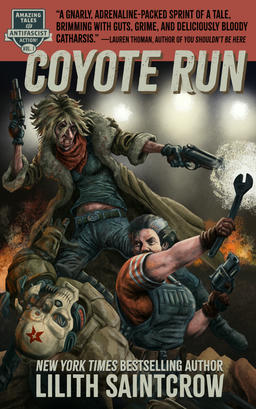A breakneck-speed novella with a metric ton of gloriously cathartic anti-fascist action—and an intriguing take on shapeshifting.
Review: Coyote Run
Arilin Thorferra

Coyote Run
Lilith Saintcrow
Horned Lark Press
February 2025
Print Edition $12.99
Ebook Edition $5.99
On social media, I joked that the pitch for Coyote Run is: “In a dystopian near-future America, a tough coyote woman punches a lot of Nazis.” While that was a bit tongue-in-cheek, it’s not wrong. (I didn’t give the title, but that was enough for someone to correctly guess.)
A civil war has fractured the United States, with part of the country now under control of the fascist dictator Lindbergh, who’s come to power on the back of mad science experiments—including both creating Aryan-esque clone soldiers and a genetically engineered variant of Covid-19 that was supposed to “clear the globe” of the impure but may have actually led to the rise of shifters. Other parts of the former US seem to have joined with Mexico or Canada.
In the midst of all this, the eponymous Coyote makes a living by taking dangerous jobs on the border of Lindyland—including crossing that border to rescue those imprisoned by the fascists. As the story opens, Marge, another shifter, comes to Coyote out of desperation: “They say you take jobs nobody else will.” And it’s a hell of a job: Marge’s sister is being held in a concentration camp, and Marge has been told she can “bring a shifter to trade for her.”
It’s clear that Marge is a shifter herself, although a “civvie,” as Coyote would have it—no direct experience with the still-raging war. Her pitch immediately sets up a terrific tension: she wants Coyote to rescue her sister, and she’s told Coyote up front that the villains claim they want a prisoner exchange. So, does she want to pretend to give Coyote to the fascists in exchange for her sister and help Coyote break her out, or does she plan to double-cross Coyote and really give her to the villains? Either way, Coyote’s in for a brutally rough time—but she can give as good as she gets.
Coyote might well kick the shit out of anyone who accused her of being heroic, but circumstances still put her on the side of the angels. And she’s tremendously fun to read about. Marge turns out to be a great character, too, not just the catalyst for the adventure. (Her relationship with Coyote plays off a meta joke that, if you catch it, comes into focus in the very last scene.)
The shifters of Coyote Run aren’t “furry” in the way the characters from previous books I’ve reviewed are. The story blurs the way they shift—how much of it is truly physical, how much is mental, how damage to the human form affects the animal form and vice-versa. This isn’t a criticism; the choice gives the milieu’s therians a distinctive specificity. Their non-human aspects remain centered in a way that a lot of furry stories don’t pull off.
And, frankly, right now couldn’t we all use a story about a tough coyote woman punching a lot of Nazis?